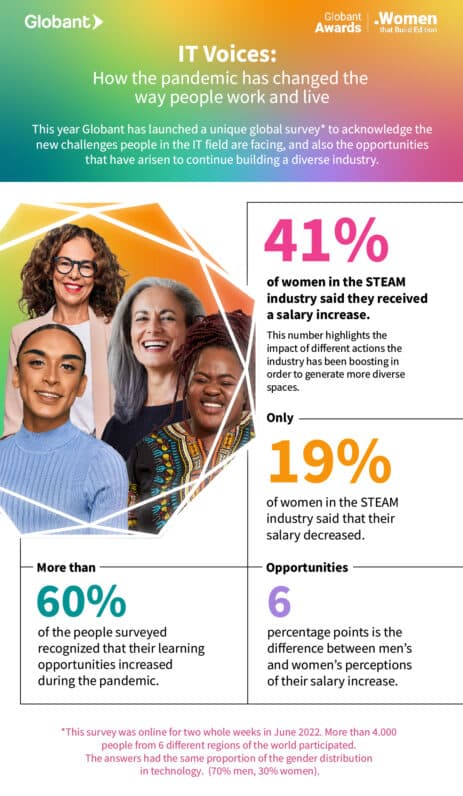In recent years, the gender gap in the STEAM areas (Science, Technology, Engineering, Mathematics, and Art) has become a topic of great relevance in education and the workplace.
One of the most resounding indicators is the gap in the labor force composition: globally, only 30% of people working in STEAM fields are women. However, women who get technology-related jobs leave the industry 45% more than men. This phenomenon is known as the Leaky Pipeline, and one of its leading causes is the lack of equal pay.
In this context, Globant launched a study called Globant IT Voices to learn how the pandemic has impacted women’s work and personal lives in the technology industry.
One of the main findings was related precisely to remuneration: only 19% of women already working in technology experienced a decreased salary. Of the remaining 81%, 41% said their salary had increased.
Furthermore, according to Pew Research Center, during the pandemic, the most significant number of lost jobs were in industries with average salaries below the mean, and those most affected were women.

Learning Opportunities
According to the World Economic Forum’s Gender Report, the enrollment of women in online technology courses has grown by six points in the last three years. Moreover, the gender gap is substantially smaller in registration for online courses than in traditional education.
Along these lines, the study promoted by Globant also identified an increase in learning opportunities. But, in this case, there were gaps between people who have children—60% of this group recognized that their opportunities increased— and those who do not have dependent minors, which was 67%.
Training proposals must consider people’s roles in their families and set out time management or determining factors that respond to these contexts. This way, we can guarantee access, continuity and completion of the learning proposals, which are key in the technological ecosystem where upskilling and reskilling are engines of growth for people and the industry.
Promotion and Growth
Access to training is critical when it comes to adapting to the needs of the industry and developing a career. For this reason, another item that the study analyzes in detail is the perception of promotion and growth opportunities offered by the industry.
To understand this topic, we take into consideration the gap that exists between those who fulfill a role with care responsibilities and those who don’t have that role.
Most participants stated that their opportunities for promotion and growth were not affected. But, more men and women with care responsibilities perceived that their opportunities for growth decreased: 19% of the total in this group versus 14% in the group without these types of tasks.
This survey showed that the technology industry creates enormous opportunities and better working conditions. It is a place where women can grow and fulfill themselves professionally.
The Role of the Private Sector
The private sector, the public sector, academia, and civil society organizations must work together to promote talent and generate tools for inclusion to ensure the employability of more women in the world of technology.
To reduce the gender gap and provide more opportunities for women in IT, Globant has created the Women that Build program, which brings together several initiatives to empower Globers and the community.
One of these actions is the Women that Build Awards, which seek to recognize and draw attention to women working in technology at all stages of their careers, reinventing their role after the pandemic, and accelerating the careers of female leaders in the STEAM industry.
Learn more about this initiative, participate, and help fight against the gender gap in IT.
Methodology: How we conducted the Globant IT Voices study
- For two weeks, an online survey was launched and distributed organically on Globant’s social networks (Instagram, Twitter, LinkedIn). 4,109 people participated, from 6 regions of the world (North America, Central America and the Caribbean, South America, Europe, Africa, and Asia), mainly between 26 and 40 years old (%), who identified themselves as: 67.7% men, 31.8% women and 0.5% other identities, which is representative of the distribution that currently exists in technology.
- When comparing gender groups, we considered men and women. Survey participants who identified as non-binary were a tiny proportion of the sample.




